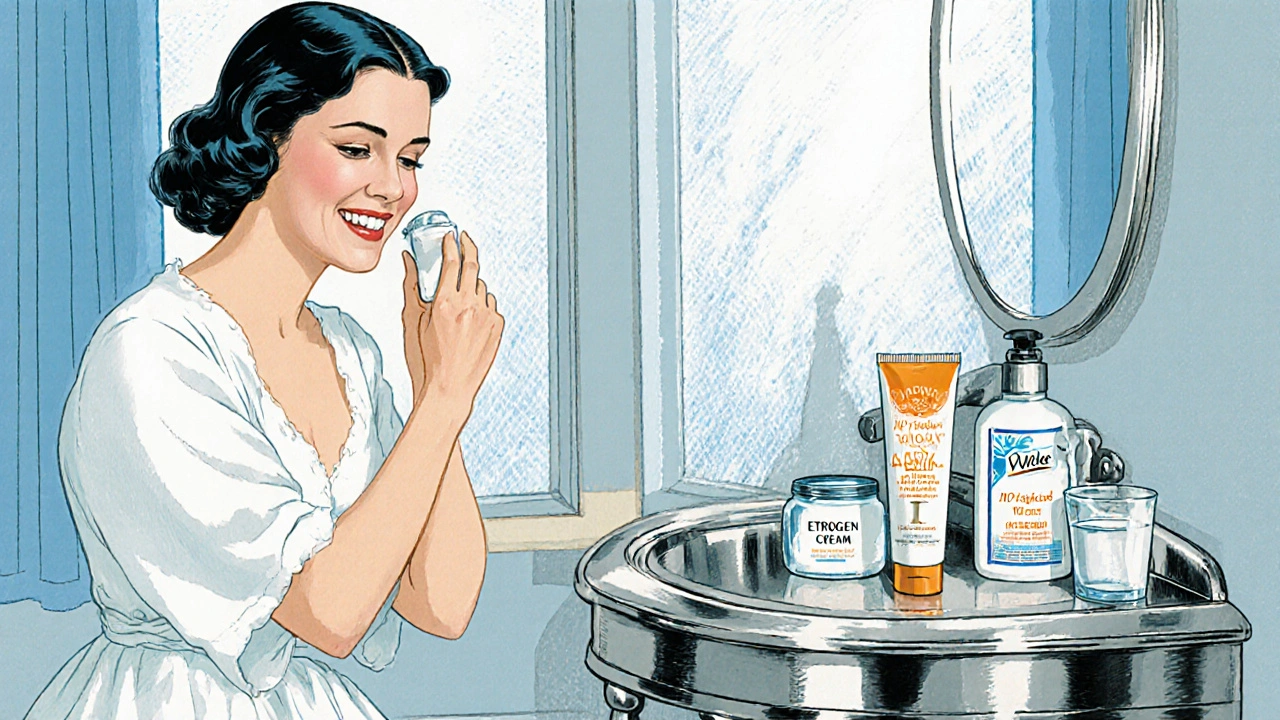Quick Takeaways
- Low estrogen during menopause often leads to atrophic vaginitis, the most common cause of irritation.
- Infections like yeast infection or bacterial vaginosis can worsen symptoms and need separate treatment.
- Non‑prescription moisturizers and lubricants help daily discomfort, while low‑dose vaginal estrogen offers lasting relief for many.
- Lifestyle tweaks-hydration, cotton underwear, gentle cleansing-reduce irritation risk.
- See a GP or gynaecologist if burning, bleeding, or discharge persist for more than two weeks.
When Vaginal irritation is described as a persistent burning, itching, or dryness, the first thing to ask is whether menopause is part of the picture. Vaginal irritation refers to any uncomfortable sensation affecting the vaginal tissue, ranging from mild dryness to painful inflammation. In the menopause stage, the body’s estrogen production drops dramatically, and that hormonal shift can thin the vaginal lining-a condition known as atrophic vaginitis.Atrophic vaginitis is the inflammation and thinning of vaginal walls caused by estrogen deficiency. Understanding why the irritation occurs is the first step toward effective relief.
Why does menopause trigger vaginal irritation?
Three biological changes drive the discomfort:
- Estrogen deficiency - Estrogen helps keep vaginal tissue supple and moist. When levels fall, the tissue loses elasticity and blood flow.
- pH imbalance - A healthy vagina stays slightly acidic (pH 3.5‑4.5). Less estrogen means less lactobacilli, raising pH and inviting unwanted microbes.
- Reduced natural lubrication - Glandular secretions decrease, leading to dryness, especially during intercourse.
These changes set the stage for irritation, but they aren’t the only culprits.
Common non‑hormonal causes that add up
Even with menopause‑related changes, other factors can aggravate the situation:
- Yeast infection (Candidiasis) - Overgrowth of Candida thrives in a high‑pH environment, causing intense itching and discharge.
- Bacterial vaginosis - An imbalance of normal bacteria leads to fishy odor and irritation.
- Irritants - Perfumed soaps, douches, scented pads, or tight synthetic underwear can strip the natural moisture barrier.
- Sexual activity - Friction without adequate lubrication often leaves micro‑tears that feel raw.
- Medical conditions - Diabetes, thyroid disorders, and certain medications (e.g., antihistamines) lower moisture levels.

How to tell if it’s hormone‑related or an infection
Distinguishing the root helps you choose the right treatment:
| Sign | Likely Hormonal (Atrophic) | Likely Infection |
|---|---|---|
| Itching | Moderate, especially after sex | Severe, often constant |
| Discharge | Thin, watery | Thick, white (yeast) or gray‑white (bacterial) |
| Odor | Usually none | Fishy (bacterial) or sweet (yeast) |
| Pain during intercourse | Common | Possible but less typical |
If you notice a sudden change in discharge colour or smell, it’s safest to see a clinician for a lab test.
Treatment options: From everyday fixes to prescription solutions
Below is a quick‑look comparison of the most used remedies.
| Treatment | Type | Typical Use | Pros | Cons |
|---|---|---|---|---|
| Water‑based lubricants | Non‑hormonal | During sex or as needed | Instant relief, OTC, no prescription | May need reapplication, can dry out quickly |
| Vaginal moisturizers (e.g., Replens) | Non‑hormonal | Every 2‑3 days | Long‑lasting hydration, safe with HRT | Doesn’t treat severe atrophy |
| Low‑dose vaginal estrogen cream | Hormonal | 2‑3 times/week | Restores tissue thickness, improves pH | Requires prescription, rare systemic absorption |
| Vaginal estrogen ring or tablet | Hormonal | Monthly insertion | Steady dose, convenient | Initial irritation, prescription needed |
| Systemic hormone replacement therapy (HRT) | Hormonal | Daily oral, patch, or gel | Addresses other menopause symptoms | Potential risks (blood clots, breast cancer) |
| Antifungal medication | Prescription/OTC | For confirmed yeast infection | Rapid symptom clearance | Doesn’t help hormonal dryness |
| Antibiotic therapy | Prescription | For bacterial vaginosis | Targets underlying bacteria | May disrupt normal flora |
For many women, a combo works best: a daily moisturizer plus an occasional low‑dose estrogen cream. If you’re already on systemic HRT, you may notice less irritation, but you still might need a lubricant for sexual activity.

Step‑by‑step plan to ease irritation now
- Check the basics: Switch to plain, unscented soap and cotton underwear. Avoid douching.
- Hydrate: Aim for 8‑10 glasses of water a day. Proper hydration helps mucosal tissues stay moist.
- Use a water‑based lubricant before any sexual activity. Apply a small amount inside the vagina if you’re not using a prescription product.
- Apply a long‑lasting moisturizer every other day. Insert the product as directed, usually at bedtime.
- Consider a low‑dose vaginal estrogen if dryness persists after 4‑6 weeks of moisturizers. Talk to your GP about a prescription cream or tablet.
- Screen for infection: If you see abnormal discharge, odor, or a burning sensation that won’t quit, book an appointment for a lab swab.
- Review medications: Some antihistamines, antidepressants, and diuretics can dry out tissues. Discuss alternatives with your doctor.
- Follow‑up: Re‑evaluate after 3 months. If symptoms improve, keep the routine; if not, your clinician may suggest higher‑dose estrogen or explore other health issues.
When to see a healthcare professional
Most irritation can be managed at home, but you should book a visit if any of the following happen:
- Bleeding after intercourse or between periods.
- Severe pain that interferes with daily activities.
- Discharge that is green, yellow, or foul‑smelling.
- Symptoms lasting longer than two weeks despite OTC attempts.
- Any concern about hormone therapy risks.
Your GP or gynaecologist can run a simple vaginal swab, check hormone levels, and tailor a treatment plan that fits your lifestyle.
Frequently Asked Questions
Can over‑the‑counter moisturizers replace prescription estrogen?
Moisturizers add surface hydration and feel better day‑to‑day, but they don’t reverse tissue thinning. If dryness is mild, they may be enough. For moderate to severe atrophy, a low‑dose vaginal estrogen usually provides more lasting relief.
Is it safe to use both systemic HRT and a vaginal estrogen ring?
Yes, many clinicians prescribe both because the ring delivers a very low dose locally while the systemic HRT handles hot flashes and bone health. Always discuss dosing with your doctor to avoid excess estrogen.
How long does it take for a vaginal estrogen cream to show results?
Most women notice reduced dryness and itching within 2‑4 weeks of consistent use. Full tissue remodeling can take up to 3 months.
Are there natural alternatives to estrogen for vaginal health?
Phytoestrogen‑rich foods (soy, flaxseed) may offer modest benefits, and over‑the‑counter lubricants plus moisturizers are safe. However, they usually don’t match the tissue‑rebuilding effect of medical estrogen.
What lifestyle habits worsen vaginal irritation?
Smoking, excessive caffeine, and chronic dehydration can dry tissues. Tight synthetic underwear and harsh soaps strip natural oils. Cutting back on these and staying hydrated helps.
By understanding the why and the how, you can take charge of menopause vaginal irritation and get back to feeling comfortable again. Remember, you’re not alone-many women face the same challenge, and effective solutions are just a conversation and a few smart choices away.




Sakib Shaikh
October 20 2025Alright folks, listen up-your vagina isn’t just “dry” because you’re getting old, it’s literally *evaporating* like a desert after a heatwave. When estrogen drops, the lining thins faster than a bad wifi signal, and that’s why you feel that burning inferno. Grab a moisturizer and consider a low‑dose estrogen cream, don’t just suffer in silence!